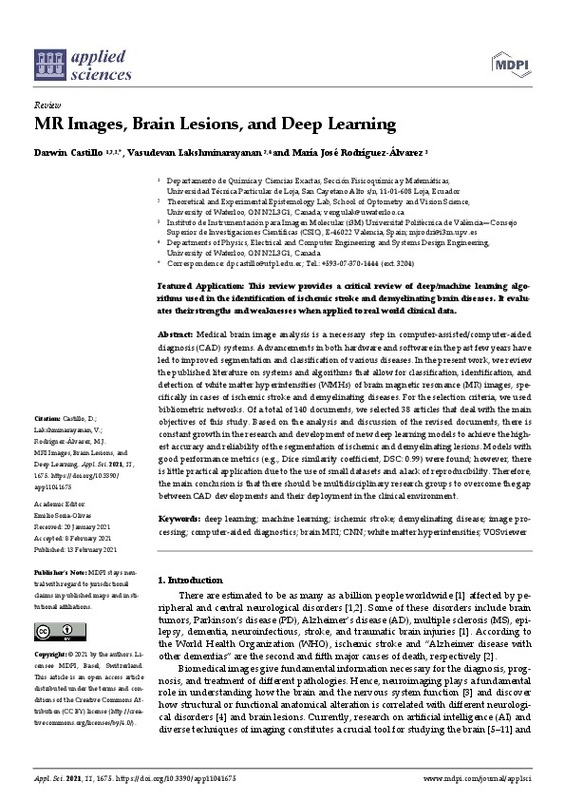JavaScript is disabled for your browser. Some features of this site may not work without it.
Buscar en RiuNet
Listar
Mi cuenta
Estadísticas
Ayuda RiuNet
Admin. UPV
MR Images, Brain Lesions, and Deep Learning
Mostrar el registro sencillo del ítem
Ficheros en el ítem
| dc.contributor.author | Castillo, Darwin
|
es_ES |
| dc.contributor.author | Lakshminarayanan, Vasudevan
|
es_ES |
| dc.contributor.author | Rodríguez-Álvarez, MJ
|
es_ES |
| dc.date.accessioned | 2022-01-27T19:03:04Z | |
| dc.date.available | 2022-01-27T19:03:04Z | |
| dc.date.issued | 2021-02-13 | es_ES |
| dc.identifier.uri | http://hdl.handle.net/10251/180284 | |
| dc.description.abstract | [EN] Medical brain image analysis is a necessary step in computer-assisted/computer-aided diagnosis (CAD) systems. Advancements in both hardware and software in the past few years have led to improved segmentation and classification of various diseases. In the present work, we review the published literature on systems and algorithms that allow for classification, identification, and detection of white matter hyperintensities (WMHs) of brain magnetic resonance (MR) images, specifically in cases of ischemic stroke and demyelinating diseases. For the selection criteria, we used bibliometric networks. Of a total of 140 documents, we selected 38 articles that deal with the main objectives of this study. Based on the analysis and discussion of the revised documents, there is constant growth in the research and development of new deep learning models to achieve the highest accuracy and reliability of the segmentation of ischemic and demyelinating lesions. Models with good performance metrics (e.g., Dice similarity coefficient, DSC: 0.99) were found; however, there is little practical application due to the use of small datasets and a lack of reproducibility. Therefore, the main conclusion is that there should be multidisciplinary research groups to overcome the gap between CAD developments and their deployment in the clinical environment | es_ES |
| dc.description.sponsorship | This project was co-financed by the Spanish Government (grant PID2019-107790RB-C22), "Software Development for a Continuous PET Crystal System Applied to Breast Cancer" | es_ES |
| dc.language | Inglés | es_ES |
| dc.publisher | MDPI AG | es_ES |
| dc.relation.ispartof | Applied Sciences | es_ES |
| dc.rights | Reserva de todos los derechos | es_ES |
| dc.subject | Deep learning | es_ES |
| dc.subject | Machine learning | es_ES |
| dc.subject | Ischemic stroke | es_ES |
| dc.subject | Demyelinating disease | es_ES |
| dc.subject | Image processing | es_ES |
| dc.subject | Computer-aided diagnostics | es_ES |
| dc.subject | Brain MRI | es_ES |
| dc.subject | CNN | es_ES |
| dc.subject | White matter hyperintensities | es_ES |
| dc.subject | VOSviewer | es_ES |
| dc.subject.classification | MATEMATICA APLICADA | es_ES |
| dc.title | MR Images, Brain Lesions, and Deep Learning | es_ES |
| dc.type | Artículo | es_ES |
| dc.identifier.doi | 10.3390/app11041675 | es_ES |
| dc.relation.projectID | info:eu-repo/grantAgreement/AEI/Plan Estatal de Investigación Científica y Técnica y de Innovación 2017-2020/PID2019-107790RB-C22/ES/DESARROLLO DEL SOFTWARE PARA UN SISTEMA PET DE CRISTAL CONTINUO APLICADO AL CANCER DE MAMA/ | es_ES |
| dc.rights.accessRights | Abierto | es_ES |
| dc.contributor.affiliation | Universitat Politècnica de València. Departamento de Matemática Aplicada - Departament de Matemàtica Aplicada | es_ES |
| dc.description.bibliographicCitation | Castillo, D.; Lakshminarayanan, V.; Rodríguez-Álvarez, M. (2021). MR Images, Brain Lesions, and Deep Learning. Applied Sciences. 11(4):1-41. https://doi.org/10.3390/app11041675 | es_ES |
| dc.description.accrualMethod | S | es_ES |
| dc.relation.publisherversion | https://doi.org/10.3390/app11041675 | es_ES |
| dc.description.upvformatpinicio | 1 | es_ES |
| dc.description.upvformatpfin | 41 | es_ES |
| dc.type.version | info:eu-repo/semantics/publishedVersion | es_ES |
| dc.description.volume | 11 | es_ES |
| dc.description.issue | 4 | es_ES |
| dc.identifier.eissn | 2076-3417 | es_ES |
| dc.relation.pasarela | S\428779 | es_ES |
| dc.contributor.funder | AGENCIA ESTATAL DE INVESTIGACION | es_ES |








